Cathedral Notre-Dame de Strasbourg is located in the Alsace region of France. Its full name is the Cathedral of our Lady of Strasbourg de Notre Dame. It is one of the finest examples of late Gothic architecture in the world. It is the second most visited church or cathedral in France, second only to Notre-Dame de Paris. Here is a complete guide to what to see and how to visit this impressive Cathedral.
A World Heritage Site
The Cathedral was the impetus for the UNESCO World Heritage designation of Strasbourg, Grande-île, and Neustadt, which are areas within the medieval historic center of Strasbourg.
The Cathedrale Strasbourg is a Roman Catholic Church renovated and essentially rebuilt (from the original church of 1015) at the end of the 12th century in a Gothic architectural style.
From 1647 until 1874 it was the world’s tallest building and today it is still the highest structure still standing that was built in the middle ages.
Victor Hugo was quoted as saying,
The church portals are beautiful, particularly the Roman portal; there are truly superb figures on horseback, the rose-window is noble and well-cut, the entire front of the church is a clever poem. But the true triumph of this Cathedral is the spire. It is a veritable tiara of stone with its crown and its cross. It is a gigantic and delicate marvel.
Victor Hugo
Goethe, who obtained his Doctor of Jurisprudence degree in Strasbourg and went on to write Faust, called the Strasbourg Cathedral “a sublimely towering, wide-spreading tree of God.“
Where can I find the Strasbourg Cathedral?
Often thought of as a German city Strasbourg is located on the French side of the Rhine River on the Eastern border with Germany. The Cathedral is a landmark that can be seen from both sides of the border.

How to get to Strasbourg
You can get to Strasbourg by fast train from either Paris or from across the river in Germany from Stuttgart or Munich.
When can you visit Strasbourg Cathedral?
The Strasbourg Cathedral is open every day although depending on the season times may vary and entry to the Cathedral is free of charge.
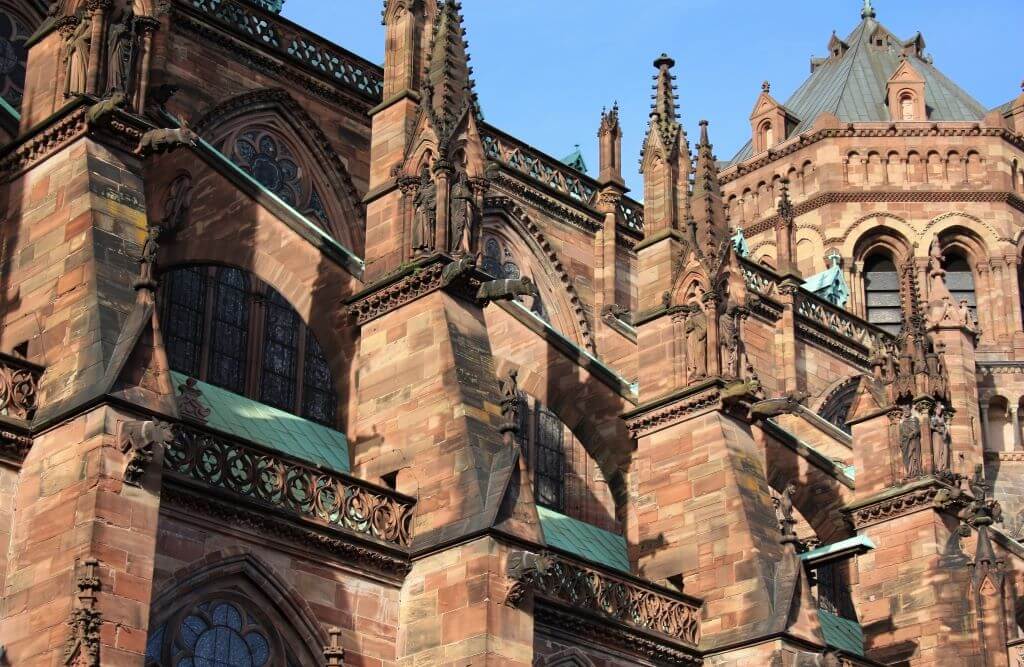
To see the Apostles animation close-up, tickets are available Monday to Saturday from noon to 12:30 pm; tickets (3€ adults, 2€ ages 5–18, and students) and you can climb the Cathedral Platform for an additional €5.
There are several tours of the Cathedral and they range in price for a group of up to 10 of €90 to around €10 euros per person for a tour in English.
A QuickHistory of the Strasbourg Cathedral
The Strasbourg Cathedral site began as a Roman Temple and the original church on the site was destroyed by fire.

In the 12th century, work began on the Cathedral we see today but it took all of the 13th century to come to fruition.
During the reformation of 1521, the Cathedral became a Protestant Church and Strasbourg became a center for Protestant refugees from France.
With its importance in the history of the Reformation, the City’s history as a printing capital allowed the Reformationists to disseminate their pamphlets and hymn books throughout France.
The City of Strasbourg holds many sites of Reformation history including the Bible Museum, The Church of St. Thomas, the Lutheran World Federations Institute for Ecumenical Research, and the Faculty of Protestant Theology with its affiliated monastery.
These sites can all be seen in Strasbourg today.
It wasn’t until 1681 that the Cathedral reverted back to Catholicism and since then its survival has been affected by the various conflicts that plagued Europe.
During the 19th century Franco-Prussian wars, the Cathedral was set on fire by missiles and during WWI although the Cathedral survived all the bells except the largest and heaviest one, were removed so as not to be melted down for weapons.
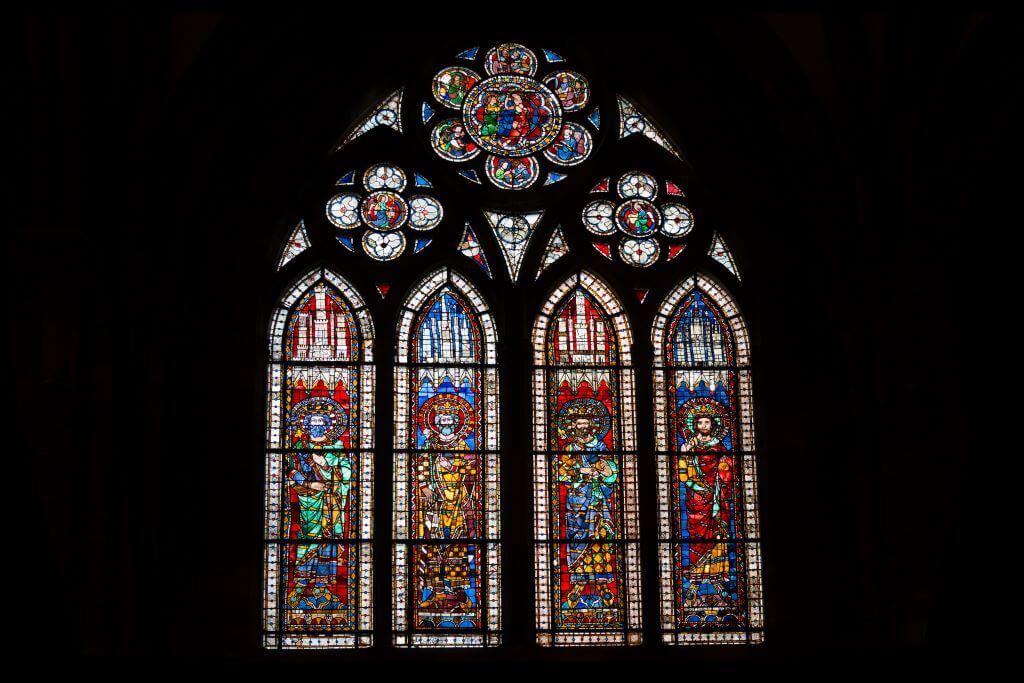
The Cathedral has endured many wars and conflicts over the centuries but it was during World War II that items like the stained-glass windows were removed on Hitler’s orders and hidden in a German Salt Mine.
It took 72 wooden cases to cart the windows away.
After the war, the stained glass was found in the Monuments, Fine Arts, and Archives section of the US military. You can see the story in the film The Monuments Men Directed by George Clooney.
Hitler also wanted to make the church a “national sanctuary of the German People” or a monument to the Unknown German Soldier but of course, he didn’t win the war.
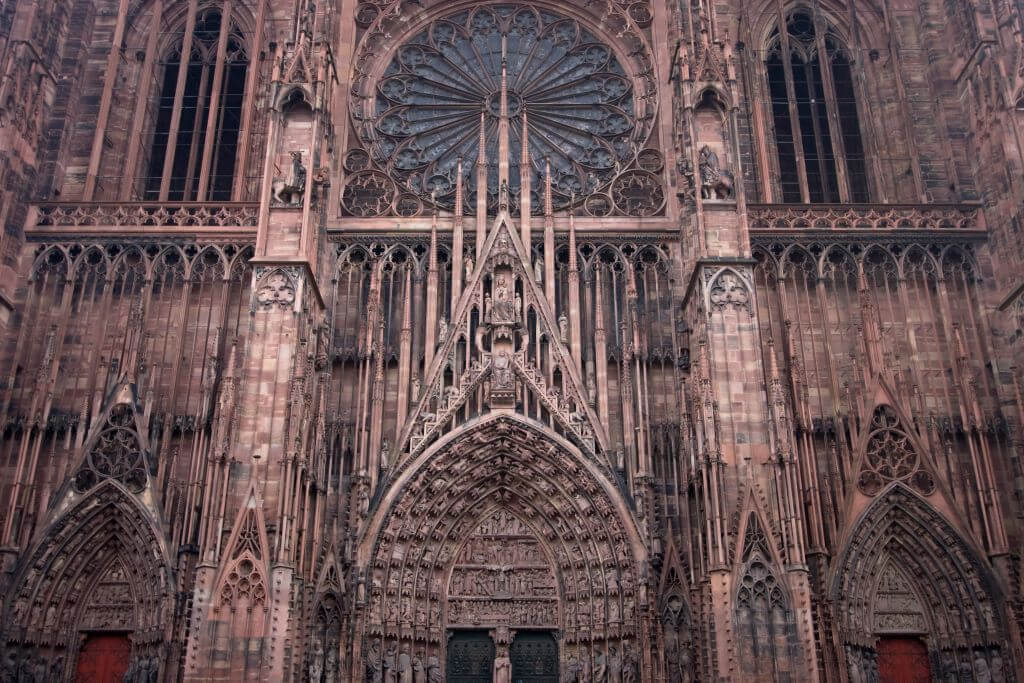
Built from a pinkish sandstone quarried in the Vosges mountains, the colors of which change depending on the light and time of day.
The city of Strasbourg has installed magical lighting effects around the Cathedral which give it an air of majesty during the evening hours.
The Cathedral has an incredibly impressive steeple that stands at over 140 meters and on the west front facade there stands thousands of figures and a carved rosette that is 15 meters across.
Each of these is highlighted in the lighting displays.
What to see inside the Strasbourg Cathedral
The incredible collection of stained-glass windows has more than 4,600 panels dating from the 12th, 13th, and 14th centuries.

The Great Rose Window masterpiece reflects the roundness of the earth, sun, and moon and symbolizes God watching over us from heaven.
These windows were often used to help illustrate the bible stories from the pulpit for those who could not read.
Inside the cathedral are some breathtaking Gothic art and exquisite sculpture, including the pulpit of Our Lady of Strasbourg which was carved out of white sandstone in 1486.
There is a stunning baptismal font in the North Transept that is detailed and intricate that was sculpted in 1453 by Jost Dotzinger.
The Cathedral also showcases early Renaissance architecture within the North transept which was built in the 1500s. Most of the statues have now been moved to the nearby Museum.
Strasbourg Cathedral Organ
Strasbourg Cathedrals outstanding organ with its golden filigreed casing measures 20 meters high and was built in 1489.
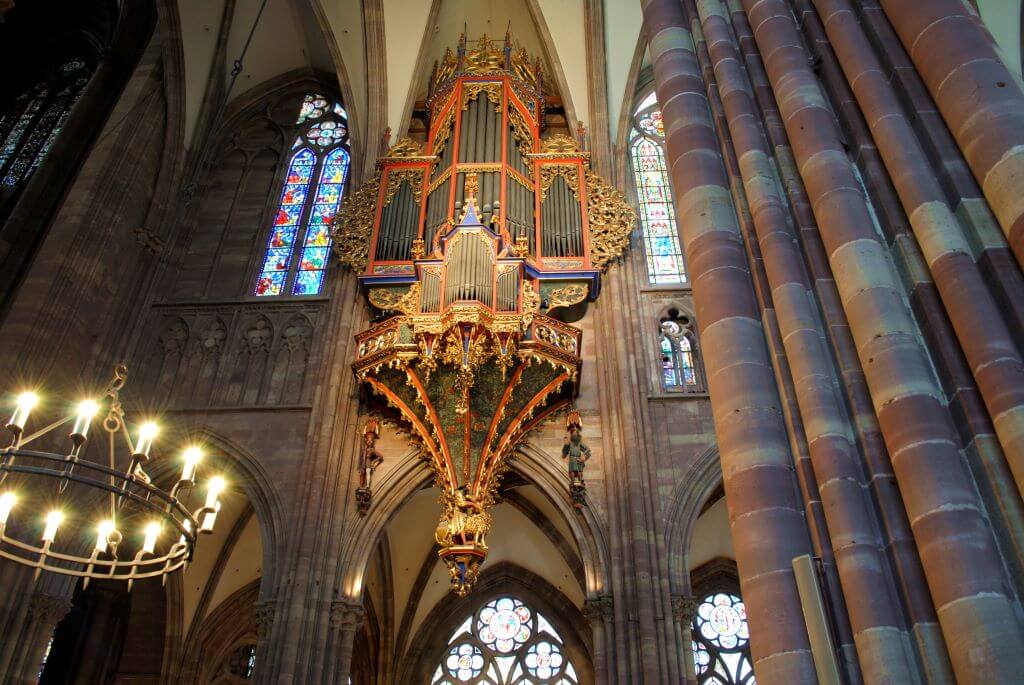
The organ itself was rebuilt in 1716 and has 3 keyboards, 2,200 pipes, and covers 3 octaves in range.
Astronomical Clock
Strasbourg Cathedrals’ world-famous astronomical clock is an ingenious piece of engineering.
Created by a team of artists, sculptors, watchmakers, and mathematicians the clock is not the first one to grace the Cathedral but it is the last and dates to 1843.

Its mechanisms include a perpetual calendar and planetary dial and displays of the positions of the sun and moon including their eclipses.
The highlight of the clock for visitors is the procession of the figures of Christ and the Apostles which takes place every day at noon when the cock crows.
Legends surrounding the Strasbourg Cathedral clock say that the man who built it should be blinded so he could never build something as grand ever again. Nobody is sure if that happened but it makes a great story.
In front of the clock stands the Pillar of Angels which is a representation of the Last Judgement. The Pillar has stood in this place for over 750 years.
There are four evangelists with symbols carved below them and above that are the four angels blowing their horns to raise the dead to heaven.
Above this stands three more angels and Christ on his heavenly throne.
One of the most intriguing spectacles within the Cathedral takes place during the spring and autumn equinoxes.
A green shaft of light moves from one window to the head of Christ on the crucifix above the pulpit. The green color comes from the shoe of Judas in another window and can only be seen on a sunny day.
The Tower
You can climb the spiral staircase to observe some stunning views of the Rhine and the surrounding countryside.

The steps are narrow there are 330 of them so the climb is quite a feat but the rewards of seeing the Rhine Valley, the Black Forest, the Vosges, and the European Parliament are worth it.
One of the most interesting and curious aspects is that the Strasbourg Cathedral south tower was planned but never built. The grand old dame remains asymmetrical!
Around Strasbourg Cathedral
The best place in Strasbourg for views and photos of the Cathedral is from the corner of Rue Mercière and Place de la Cathédrale.

Across from the Cathedral, you will see the Musée de l’Oeuvre Notre-Dame, which manages the protection and maintenance of the cathedral. The Museum also contains the original artwork, sculptures, and tapestries from the Cathedral that were replaced by copies.
The Palais Rohan which sits beside the Cathedral is the former residence of the Bishops and Cardinals and is considered one of the finest examples of French Baroque architecture.
Designed by Robert de Cotte it was finished in 1742 and hosted many French luminaries such as Louis XV and Marie Antoinette, and Napoleon and Josephine.
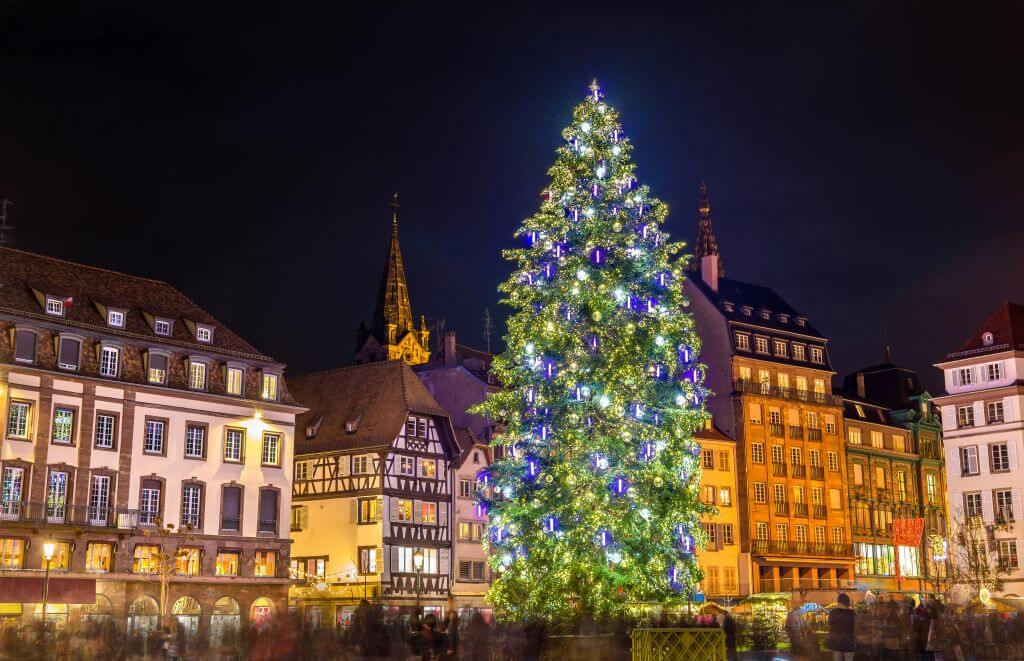
If you are lucky enough to be in Strasbourg at Christmas time you can visit the Christmas market (Christkindelsmärik) that is held around the Cathedral.
Fortunately, in 2000, the French and German police foiled a terrorist attack on the market that would have destroyed the historic center of Strasbourg.

The Sainte-Madeleine Church is another fascinating location to see in Strasbourg. It was the first convent dedicated to the Magdalene in 1225 and was classified as a national monument in 1898.
It was built in the French Gothic style but sadly it burnt down in 1904, was rebuilt, and destroyed again during WWII.
Its original frescos were preserved and the convent became a chapel. After the war, it was reconstructed and unchanged.
Keep Planning Your Trip to France
🧳 Chateau Amboise: Death and Intrigue in the Loire Valley
🧳 Castle Chenonceau: Loire Chateau of Powerful Women
🧳 Strasbourg Cathedral: A Gothic Masterpiece
🧳 The Ultimate Parisian Landmark list: best 45 to visit in 2024
🧳 Incroyable! 61 France Landmarks to visit in 2024
🧳 France
